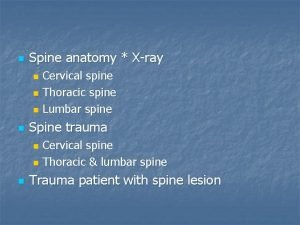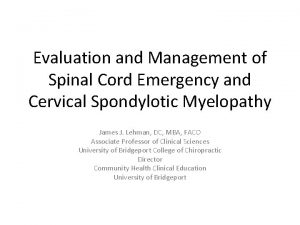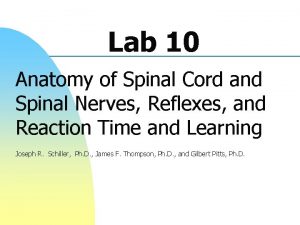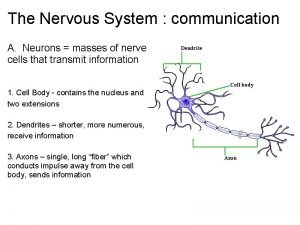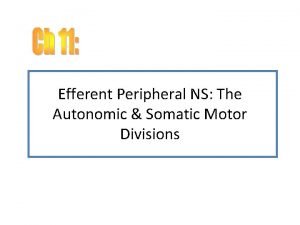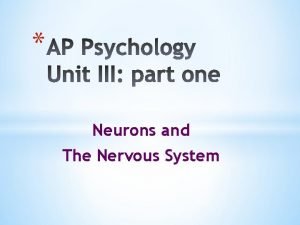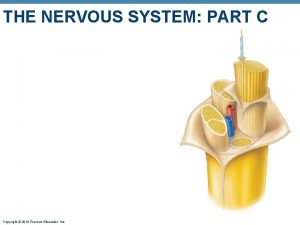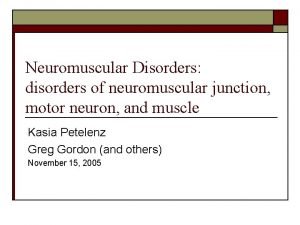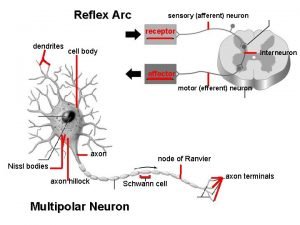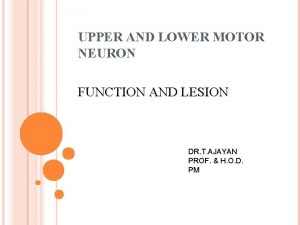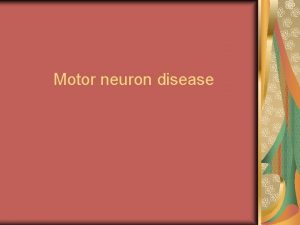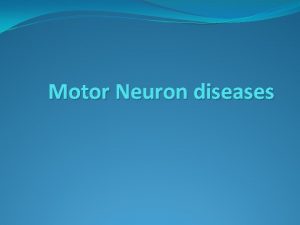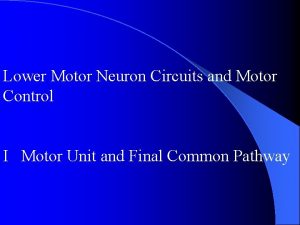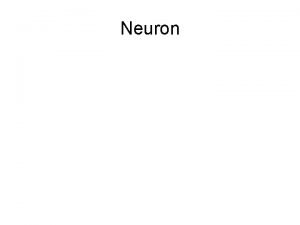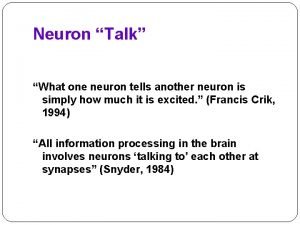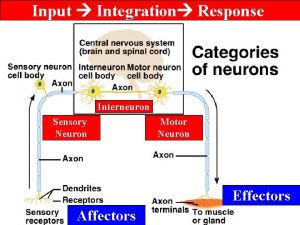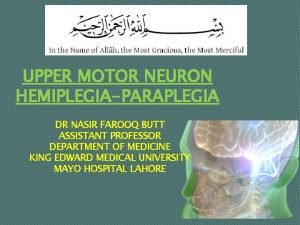Upper Motor Neuron Lesion UMNL Pyramidal Lesion Lower

















- Slides: 17

Upper Motor Neuron Lesion (UMNL , Pyramidal Lesion) & Lower Motor Neuron lesion (LMNL) Dr. Taha Sadig Ahmed , Clinical Neurophysiologist Textbook : Review of Medical Physiology (Ganong) 1

Upper Motor Neuron Lesion ( UMNL ) Ø In upper motor neuron (pyramidal) lesion , the spinal cord is disconnected from the modulating influences of the supraspinal controlling centers. Ø Although the supraspinal centers exert both inhibitory & facilitatory effects on the spinal reflex stretch reflex(and consequently on muscle tone), the net inhibition exceeds the net excitation. Ø Therefore , in UMNL , after a period of “ spinal shock ” , the stretch reflex recovers , but resumes function in a primitive and uninhibited manner : there are exaggerated tendon reflexes and “ spastic ” increase in muscle tone , greater in the extensors of the lower limbs (LLs ) and the flexors of the upper limbs ( ULs). 2

Lower Motor Neuron Lesion ( LMNL ) Ø The lower motor neuron ( LMN) constitutes part of the reflex arc, and as you know from reflexes , the integrity of the reflex arc is essential for (1) maintenace of muscle tone , & (2) adequate nutrition of the muscle itself. Ø Therefore, LMNL lesion leads to atonia or hypotonia , lost or depressed tendon reflexes , and muscle atrophy. (wasting ). Ø The denervated muscle fibers depolarize spontaneously causing fibrillations potentials ( not visible to the naked eye , but detectable only by electromyography , EMG ). Hence , in the EMG , fibrillation potentials indicate muscle denervation. Ø Re-innervation of denervared fibers from neighbouring motor units may occur. In that case , however , the neuromuscular junctions of the enlarged motor units are unstable , and depolarize spontaneously, causing fasciculations. These are contractions of groups of motor units , and are visible to the naked eye. In other words , fasciculations indicate partial re-innervation. 3

Examples of Conditions in Which there is UMNL or LMNL Upper Motor Neuron Lesion ( UMNL) Lower Motor Neuron Lesion, ( LMNL) Can result from (1) Spinal root lesions or (1) Haemorrhage , peripheral nerve lesion thrombosis or embolism in the internal capsule ( e. g. nerve injury by trauma or compressive lesion (2) Spinal cord transection or hemisection (2) Anterior horn cell lesions (Brown- Sequard syndrome ) ( e. g. , poliomyelitis, motor neuron disease )

Principal Features of UMNL & LMNL UMNL: (1) No muscle wasting, except from disuse ( disuse atrophy) (3) Spasticity ( hypertonia ) , called “ clasp-knife spasticity ” (4) Clonus present (5) Brisk ( exaggerated ) tendon jerks (6) Extensor plantar reflex , Babinski sign ( dorsiflexion of the big toe and fanning out of the other toes ) (7) Absent abdominal reflexes (8) No fasciculations (9) No fibrillation potential in EMG LMNL: (1) Marked muscle wasting (atrophy ) (3) Flacidity (Hypotonia ) , hence given the name “ flaccid paralysis ” (4) No clonus (5) Diminished or absent tendon reflexes (6) Absent plantar reflex (normally it is flexor ). (7) Absent abdominal reflexes (8) Fasciculations may occur. (9) Fibrillation potentials present. 5

Hemiplegia (1) Causes : cerebral heamorrhage , thrombosis or embolism results in paralysis of the oppsite half of the body. The commonest cause of cerebral haemorrhage is hypertension , usually associated with rupture of the lenticulo striate branch of the middle cerebral artery in the internal capsule. Features : (1)UMNL involving the half of the body contralateral to the site of the lesion. (2) Hypertonia causes the limbs to acquire a specific posture A/ upper limb is (a) adducted to the side of the trunk , (b) flexed at the elbow , (c) the forearm is semipronated, (d) with flexion of the wrist and fingers. 6

Hemiplegia (2) B/ lower limb is (a) adducted and (b) extended at the knee and ankle. every now and then , we may have , in addition : (3) Loss of sensation on the opposite side of the body (Hemianesthesia), due to damage of the thalamocortical fibers. (4) Homonymous hemianopia ( loss of vision in two corresponding halves of the visual fields in both eyes), may occur if the optic radiation is lesioned In extensive lesions the patient may have , in addition : (3) Loss of sensation on the opposite side of the body (Hemianesthesia), due to damage of the thalamocortical fibers. (4) Homonymous hemianopia ( loss of vision in two corresponding halves of the visual fields in both eyes), may occur if the optic radiation is lesioned 7

Paraplegia (1) Due to complete spinal cord transection ( e. g. following tumor , trauma ( e. g. bullet injury , fractures spine , etc ) • • The higher the level of the section, the more serious are the consequences. If the transection is in the upper cervical region immediate death follows, due to paralysis of all respiratory muscles; In the lower cervical region below the 5 th cervical segment diaphragmatic respiration is still possible, but the patient suffers complete paralysis of all four limbs (quadriplegia). Transection lower down in the thoracic region allows normal respiration but the patient ends up with paralysis of both lower limbs (paraplegia). 8

Paraplegia (2) , Stages : A/ Spinal shock B/ Recovery of reflex activity C/ Paraplegia in extension A/ Spinal shock In the immediate period following transection there is : (1) complete loss of spinal reflex activity below the level of the lesion. (2) Loss of all sensations (anesthesia) and voluntary movement ( paralysis) below the level of the lesion , due to interruption of all sensory and motor tracts (3) Loss of tendon reflexes and superficial reflexes (abdominal , plantar & withdrawal reflexes ). (5) The loss of muscle tone (flaccidity) and absence of any muscle activity (muscle pump ) lead to decreased venous return causing the lower limbs to become cold and blue in cold weather 9

Paraplegia 3 (6) The wall of the urinary bladder becomes paralysed and urine is retained until the pressure in the bladder overcomes the resistance offered by the tone of the sphincters and dribbling occurs. This is known as retention with overflow. (7)Loss of vasomotor tone occurs, due to interruption of fibers that connect the vasomotor centres in the medulla oblongata with the lateral horn cells of the spinal cord, which project sympathetic vasoconstrictor impulses to blood vessels. vasodilatation causes a fall in blood pressure; the higher the level of the section, the lower the blood pressure. This stage varies in duration but usually lasts a maximum of 2 -6 weeks, after which some reflex activity recovers. 10

Paraplegia (4) B/ Stage of Return of Reflex Activity • As the spinal shock ends , spinal reflex activity appears again this partial recovery may be due to: 1. increase in the natural degree of excitability of the spinal cord neurons below the level of the section, presumably to make up for the loss of supraspinal facilitatory influences. 2. It may also be due to sprouting of fibres from remaining inputs. 11

Paraplegia (5) Features of the stage of recovery of reflex activity (1) 1. Gradual rise of arterial blood pressure due to return of spinal vasomotor activity in the lateral horn cells. But, since vasomotor control from the medulla is absent, the blood pressure is not stable. 2. Return of spinal reflexes: Flexor reflexes return earlier than extensor ones. Babiniski sign is one of the earliest signs of this stage. Deep reflexes also recover earlier in flexors. As a result, flexor tone causes the lower limbs to take a position of slight flexion, a state referred to as paraplegia in flexion. The return of the stretch reflex ( & cosequently muscle tone) , and vasoconstrictor tone in arterioles and venules improve the circulation through the limbs. 3. Recovery of visceral reflexes: return of micturition, defecation & erection reflexes. 4. However , voluntary control over micturition and 12 defecation , and the sensation of bladder and rectal fullness are

Paraplegia (6) Features of the stage of recovery of reflex activity (2) 5. Mass reflex appears in this stage: A minor painful stimulus to the skin of the lower limbs will not only cause withdrawal of that limb but will evoke many other reflexes through spread of excitation (by irradiation) to many autonomic centers. So the bladder and rectum will also empty, the skin will sweat, the blood pressure will rise Since effective regeneration never occurs in the human central nervous system, patients with complete transection never recover fully. Voluntary movements and sensations are permanently lost; however, patients who are rehabilitated and properly managed may enter into a more advanced stage of recovery. 13

Paraplegai (7) C. Stage of Paraplegia in Extension 1. During this stage the tone in extensor muscles returns gradually to exceed that in the flexors. The lower limbs become extended. Extensor reflexes become exaggerated, as shown by brisk tendon jerks and by the appearance of clonus. The positive supportive reaction becomes well developed and the patient can stand on his feet with appropriate support. 2. The flexor withdrawal reflex which appeared in the earlier stage is associated during this stage with the crossed extensor reflex. 14

Hemisection of the spinal cord ( Brown-Sequard syndrome) Occurs as a result of unilateral lesion or hemisection of the spinal cord ( e. g. due to stab injury, bullet , car accident, or tumor ). Let us take an example of such injury involving the thoracic spinal cord : The manifestations of the Brown Sequard syndrome depend on the level of the lesion. A/ At the level of the lesion, all manifestations occur on the same side: 1. Paralysis of the lower motor neuron type, involving only the muscle supplied by the damaged segments. 15

Brown –Sequard Syndrome (2) 2. Vasodilatation of the blood vessels that receive vaso constrictor fibres from the damaged segments. 3. Loss of all sensations in the areas supplied by the afferent fibres that enter the spinal cord in the damaged segments +/ band of hyperesthesia B/ Ipsilaterally ( on the same side of lesion ) below the level of the lesion : 1. spastic lower limb (with upper motor neuron type of lesion ). Why ? 16

Brown-Sequard syndrome (2) 1. Fine touch, position and vibration sense are lost , as a result of damage of the dorsal column tracts. 2. Vasodilatation due to interruption of the descending pathways from the medullary vasomotor centres. C/ On the opposite side to the lesion : Pain and temperature sensations are lost, Why ? 17
 Paraplrgia
Paraplrgia Upper motor neuron lesion
Upper motor neuron lesion Princip alternatora
Princip alternatora Lower motor neuron
Lower motor neuron Anal wink reflex
Anal wink reflex Site of somatic motor neuron cell bodies
Site of somatic motor neuron cell bodies Upper motor neuron
Upper motor neuron A motor unit consists of:
A motor unit consists of: Somatic motor neuron
Somatic motor neuron Motor neuron adalah
Motor neuron adalah Skeletal muscle autonomic nervous system
Skeletal muscle autonomic nervous system Motor (efferent) division
Motor (efferent) division Motor neuron adalah
Motor neuron adalah Spinal cord diagram
Spinal cord diagram Somatic motor function
Somatic motor function Motor neuron
Motor neuron Site of somatic motor neuron cell bodies
Site of somatic motor neuron cell bodies Somatic motor pathways
Somatic motor pathways




